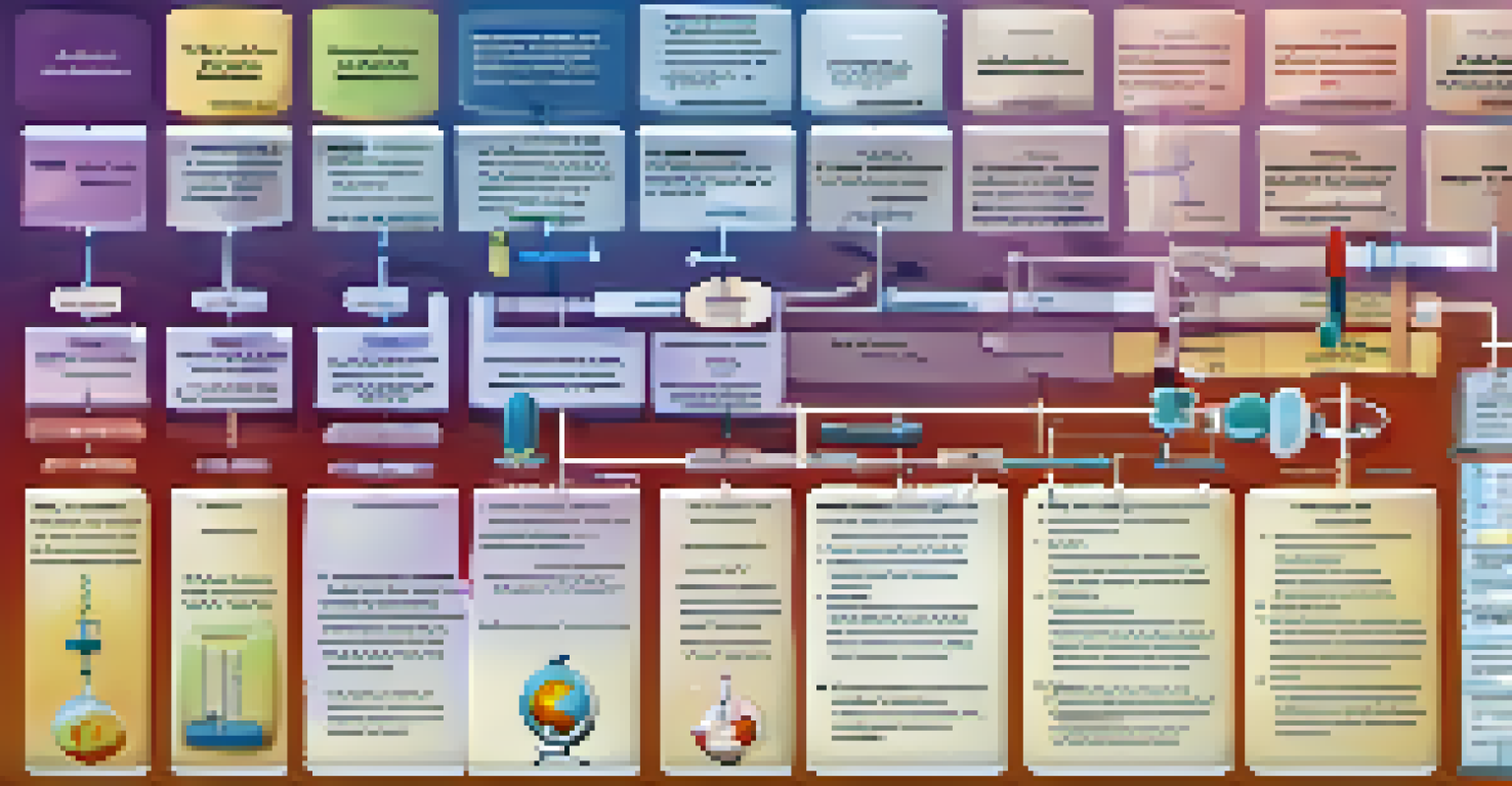From Discovery to Application: The Translational Medicine Path

Understanding Translational Medicine and Its Importance
Translational medicine bridges the gap between laboratory research and clinical application. It focuses on converting scientific discoveries into practical treatments for patients. This process is crucial as it ensures that the benefits of research reach those in need quickly and effectively.
Translational medicine is the process of turning scientific discoveries into real-world applications that can improve patient health.
For instance, a breakthrough in cancer research may lead to new therapies that can significantly improve patient outcomes. Without translational medicine, many promising discoveries might remain locked in the lab, unable to help anyone. Thus, it plays a pivotal role in the healthcare innovation landscape.
By facilitating collaboration among researchers, clinicians, and patients, translational medicine fosters a holistic approach to health. It emphasizes understanding patient needs and experiences, ensuring that new treatments are not only effective but also relevant.
The Stages of Translational Medicine Explained
Translational medicine typically unfolds in several key stages, often referred to as T0 to T4. T0 involves basic research where scientists explore fundamental biological questions. T1 moves this knowledge into preclinical studies, assessing the feasibility of new treatments in controlled environments.

Next, T2 focuses on clinical trials, where these treatments are tested on human participants for safety and efficacy. Following successful trials, T3 sees the application of these treatments in clinical settings, allowing for real-world patient care. Finally, T4 emphasizes the broad application of these innovations in public health.
Translational Medicine Defined
Translational medicine is vital for turning laboratory discoveries into effective treatments for patients.
Each stage is crucial and builds on the previous one, ensuring that discoveries are rigorously tested and refined before reaching patients. This structured approach helps mitigate risks and enhances the likelihood of successful outcomes.
Identifying Research Gaps and Opportunities
A critical aspect of translational medicine is identifying gaps in current research and understanding where new opportunities exist. This involves analyzing existing treatments and their limitations, which can often spotlight areas needing further investigation. For example, if a particular drug shows limited effectiveness, researchers may explore alternative compounds or delivery methods.
The future of medicine is not just about treating diseases, but about understanding the individual needs of patients and tailoring treatments to them.
Moreover, patient feedback and real-world data play a significant role in guiding research priorities. By listening to patients' experiences, researchers can tailor their studies to address the most pressing health issues. This patient-centered approach not only enhances the relevance of research but also fosters trust between the medical community and the public.
Ultimately, recognizing these gaps serves as a catalyst for innovation, propelling the field forward. It encourages a continuous cycle of improvement, ensuring that translational medicine evolves along with our understanding of health and disease.
Collaboration: The Heart of Translational Medicine
Collaboration is essential in translational medicine, as it brings together diverse expertise from various fields. Researchers, clinicians, and industry professionals must work hand-in-hand to navigate the complex journey from bench to bedside. This teamwork not only enhances the research process but also accelerates the development of new therapies.
For example, partnerships between academic institutions and pharmaceutical companies can streamline the transition of discoveries into viable products. Such collaborations often lead to shared resources, knowledge, and funding, which can significantly bolster the research efforts. By leveraging each other's strengths, these entities can drive innovation more efficiently.
Collaboration Drives Innovation
Successful translational medicine relies on collaboration among researchers, clinicians, and patients to enhance treatment development.
Furthermore, engaging patients and advocacy groups in the research process adds another layer of collaboration. Their insights can guide researchers in developing treatments that truly meet patient needs, ensuring that the end results are both effective and meaningful.
The Role of Technology in Translational Medicine
Technology plays a transformative role in translational medicine, enabling researchers to gather and analyze data more efficiently than ever. Advanced tools such as genomics, bioinformatics, and artificial intelligence are revolutionizing how we understand diseases and develop treatments. For instance, AI algorithms can sift through massive datasets to identify potential drug candidates.
Moreover, digital health technologies are enhancing patient engagement and data collection. Wearable devices and mobile health applications allow for continuous monitoring of patient health, providing invaluable real-world evidence that can inform research. This real-time data can help researchers fine-tune their approaches and better understand treatment outcomes.
Ultimately, technology not only accelerates the translational process but also enriches it by providing deeper insights. As we continue to innovate, the integration of technology will likely lead to even more breakthroughs in the field.
Regulatory Challenges in Translational Medicine
Navigating regulatory pathways is one of the significant challenges in translational medicine. Regulatory bodies, such as the FDA, set stringent requirements to ensure that new therapies are safe and effective before they can be introduced to the market. While these regulations are crucial for patient safety, they can also slow down the translation process.
For instance, the process of obtaining approval for clinical trials can be time-consuming, requiring extensive documentation and ethical reviews. Researchers often find themselves balancing the need for thorough evaluation with the desire to expedite patient access to new treatments. This delicate balance is essential for fostering innovation while safeguarding public health.
Technology Enhances Research
The integration of advanced technologies like AI and genomics accelerates the translational process and improves treatment outcomes.
Understanding and navigating these regulatory landscapes is vital for successful translational efforts. By fostering open communication between researchers and regulatory agencies, we can work toward streamlined processes that still prioritize safety and efficacy.
Future Directions in Translational Medicine
The future of translational medicine holds exciting possibilities as we continue to bridge the gap between research and application. With advancements in personalized medicine, treatments are becoming more tailored to individual patient profiles, enhancing their effectiveness. This shift toward personalized approaches signifies a new era in healthcare, where one-size-fits-all solutions are increasingly being replaced.
Moreover, as we continue to harness the power of big data and artificial intelligence, the potential for predictive modeling in translational medicine expands. This could lead to more accurate predictions of treatment outcomes and quicker identification of promising therapies. The integration of these technologies is set to reshape our understanding of diseases and how we treat them.

As collaboration between academia, industry, and healthcare providers strengthens, the translational medicine landscape will become more dynamic. With a shared commitment to improving patient outcomes, we can anticipate a future where breakthroughs in research translate into tangible health benefits more swiftly and effectively.